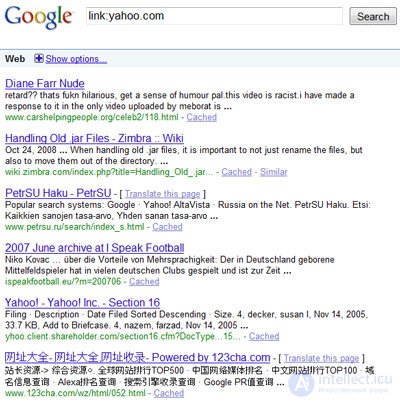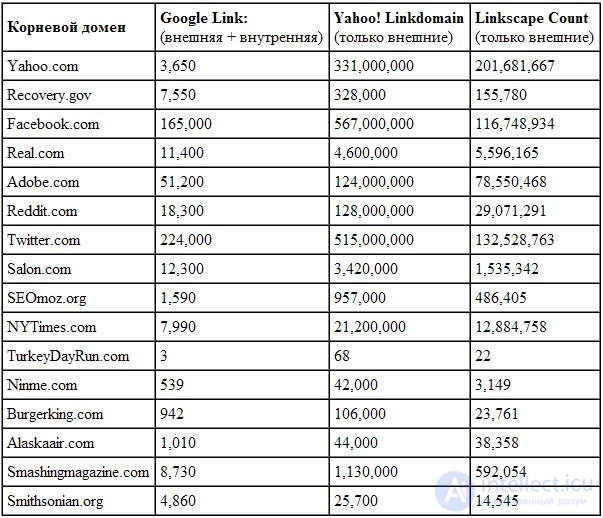Lecture
I don’t like Google’s search link directive “link:” and I’m just shocked by the huge number of people inside and around the SEO industry who use it without even knowing that something could be wrong with it.
Here is what Google itself said about this:
In order to see a more detailed list of incoming links, you need to register the site with Google Webmaster Tools :
Note: Not all links to your site may be listed. It's quite normal.
Further more, here is what Matt Cutts (head of anti-spam Google) said about this:
In fact, we show a relatively small percentage of links, from those that can be real. I think this is the right decision because if we show all the links, or most of them, then this information can be used by hackers, spammers or competitors and use it against the site itself.
Google itself personally , and unequivocally states that the search operator " link: " should not be taken too seriously, but it seems that it doesn’t worry too much about some hard-nosed optimizers, and they continue to do everything as before.
Not! Not even close. Google has personally claimed that the number of links that they show in the SERP is only a sample and this list can not be considered complete, all the more so to rely on it in their professional activities.
The numbers confirm this. First, check the number of links by the search operator "link:" and then compare with the number that is displayed in Google Webmaster Tools (you can only see them after registering an account).
To simplify your task, I decided to show it on the example of my intellect.icuwebsite:

So, after using the search directive "link:" I saw 1590 links . What we now Google Webmaster Tools will say:

Hmm ... 381.403 "little" more than 1590 .
In fact, the search directive "link:" showed me only 0.4% of the amount I saw in Google Webmaster Tools.
To be finally sure that such a huge variation in the results is not an accident, I repeated my mini-experiment on several other sites. The result for me did not come as a surprise, I saw numbers from 0.1% to 4.4% (this shows us that even the percentage difference is not a constant value).
It's sad to talk about this but, once upon a time (before-2004), Google did show the most good links through the search operator "link:", which was the reason for the emergence of this myth, as if this is what it is today.
In fact, those links that are displayed in the SERP after using this operator do not have any special importance or relevance. They are arranged in random order for example only, including among them there are also links closed with the "nofollow" tag, from pages that are under filters, as well as links that do not convey any weight at all.
No one among the optimizers was able to prove that the SERPA links after using the search directive "link:" are sorted in some logical order.
An authoritative, well-known site can once float to 2 positions, another time to 20, and a third time to 200, along with low-quality, spamming sites interspersed.
In Site Explorer, it seems that Yahoo! does some sorting of the results, trying to show at the top of the list the most important links, pages and sites and below them less important (although not in large numbers).
Unfortunately, many optimizers do not pay attention to it. As for Microsoft, it seems to me that they use the results of Yahoo! they hardly have their own link index.

In the example that you see above, it is quite obvious that Google sorted the results in a random order.
This is probably the biggest misconception, mainly because so many practicing optimizers rely on data about links to the site that are obtained using the "link:" directive, almost considering this information useful and truthful puzmerkoy.
There is nothing more true than this - I specifically provide information that confirms my words:

I have collected only superficial information without much depth, therefore I do not claim absolute statistical accuracy.
Just look at NYTimes.com - as Google shows, they have 2/3 links from the number of Salon.com, and at the same time Yahoo! and Linkscape show equally that NYTimes.com has 6X + links from their number at Salon.com.
These are not the numbers you should rely on when you make some important business decisions.
Unfortunately, I do not have an example on which I could confirm my opinion, but according to my observations for a long time the number of links displayed in Google Webmaster Tools will grow, as well as in Yahoo! and Linkscape, but at the same time in SERPa after using the "link:" operator, on the contrary, it decreases with time.
The reasons for this reversal are not completely clear to me. With such unexplained fluctuations, we can not trust the number of links that shows Google after using the operator "link:".
Most optimizers and webmasters have probably already noticed that the links that we see in SERP after using the search operator "link:" are either outdated, or there are no fresh ones in the list.
Updating reference information occurs much less frequently than updating PageRank. These updates happen every 2-10 months without any prior notification, when the reference pattern could change drastically. It is unlikely that someone has a desire to use outdated information.
Comments
To leave a comment
seo, smo, monetization, basics of internet marketing
Terms: seo, smo, monetization, basics of internet marketing